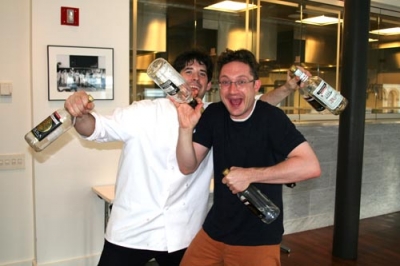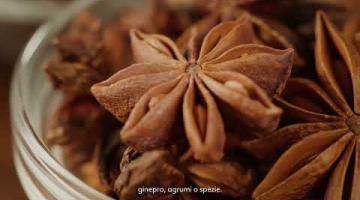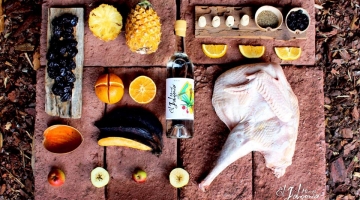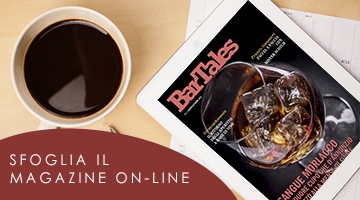As I mentioned in my last post: Last week I participated in a seminar at Tales of the Cocktail entitled The Science of Shaking. The panel was put together by moderator Eben Klemm (head of bar programs for the B. R. Guest restaurant empire, well-known innovative cocktail guy, and former biologist) with Alex Day (famed bartender from Death & Company and Franklin Bar) and myself as panelists. Yesterday, we went over some basic cocktail science. Today we are talking simple results.
Question
When it comes to determining the final temperature and dilution of a shaken drink, does the type of ice in the shaker or the shaking style really matter?
Short Answer
No (within limits).
Important Note
We did not address drink texture in any way. We first wanted to understand temperature and dilution. Texture is vitally important. We hope to address that in the future.
Assumptions
- Bar ice is 0° Celsius (it isn’t stored in a freezer). This is important. If your ice is in the freezer, it can chill your drink before it starts to melt. The ice will lower the temperature of your drink while getting warmer till it hits 0° C. After the ice gets to 0° C, it doesn’t get any warmer. ALL FURTHER CHILLING IS DONE BY MELTING ALONE. In a bar situation, all chilling is done by melting. There is no chilling without dilution.
- You use “enough” ice. We did initial experiments that showed that using too little ice results in poor chilling and greater dilution. The benefit of adding more ice plateaus at a certain point so that it neither helps nor hurts the temperature or dilution. I don’t have exact numbers for the plateau point (I lost my old data cause I’m a jerk), but using Kold-Draft ice, Eben and Alex shook a 100 ml gimlet with one cube, two cubes, three cubes, and up. They were able to keep getting better results up to at least 5 cubes.
- You don’t use ice so broken down that it carries a huge amount of water with it. The volume of an ice cube goes up as the third power of its size, but the surface area goes up as the square of the size. Small ice cubes, therefore, have a larger surface area per gram than large ice cubes. Since water resides at the surface of wet ice, immense amounts of surface area will unfairly add to dilution.
- You shake “enough.” Putting ice in the drink and walking away doesn’t constitute shaking. You need enough agitation to get fresh drink in contact with the ice. It doesn’t take a whole hell of a lot, as we shall see.
What We Did
- I made some temperature recording shakers by soldering together some type K thermocouple wire, lightly coating the end with heat conductive epoxy (to prevent wicking into the thermocouple insulation), drilling holes into some cocktail shakers, and sealing the thermocouples inside with some steel-reinforced epoxy. These were wired into a Measurement Computing 8 channel thermocouple receiver attached to my computer.
- We took a whole bunch of Montezuma Tequila and Calypso white rum and verified their alcohol content with a refractometer calibrated for ABV (alcohol by volume). All the bottles measured 38% ABV instead of the advertised 40%. We then cracked open some liquor that cost more than five bucks a bottle and it also registered 38, so we learned that Montezuma wasn’t ripping us off. Our refractometer was a bit off.
- We put all the liquor in a controlled water bath set at 75° F. This was our “room temperature.”
- We put a bunch of Kold-Draft ice and a bunch of small ice (made by our machine) into a Randell FX adjustable refrigerated drawer set to 0° C and let it equilibrate for 2 hours. The side of a cube of Kold-Draft measures 1.25 inches across. Many bartenders prefer it because the say it dilutes drinks less. Some people also think it is somehow “colder.” Our small cubes measured .75 inches across a side but had a large simple which increases its surface to volume ratio significantly.
- For every shake we weighed out similar quantities of ice, recorded the weights, and shook with 100 ml of room temp liquor (deviations of weight in ice are presented at the bottom of the post).
- After every shake we strained the drinks into a fresh room temperature Dixie cup and measured its temperature with a calibrated thermocouple probe (the straining involved some snaps of the wrist to ensure we got all the drink out).
- After the temperature was taken, the drink was poured into a labeled plastic bag sealed and thrown into a 75° F water bath. The residual ice was also bagged and thrown into the water bath.
- After the samples reached room temperature, they were weighed and alcohol level was checked with the refractometer.
-
Notes: Yes, we corrected for the differences between weight and volume, and alcohol by volume and alcohol by weight in our calculations. No, there was no sugar or anything else in the liquor to throw off the refractomer readings.
First Experiment
Does type of ice or shaking style affect how cold a drink is or how fast it gets cold? No.The shaky lines are the actual bits of data from the thermocouple. They go up and down as the drink was shaken. The smooth lines are Excel’s 6th order polynomial curve-fit to the thermocouple data (whoa). Crazy Monkey is me, so named because I shook as hard as I could. I shook so hard that by the end of the shaking I couldn’t move my arms and had to jump up and down to keep going. Notice that even going crazy monkey, all of our final temperatures are about the same, regardless of shaking style and regardless of type of ice. Also notice that the smaller ice is marginally faster than the Kold-Draft, but not by much (that makes sense because it has more surface area). In fact, with the exception of Alex’s first shake (which was the first shake of the day so it might be an anomaly), all the shakes had almost leveled out by 12 seconds. After that we only gained a degree or two of cooling. A degree ain’t no big deal. So much for big ice being “colder.” If anything, the reverse is true. So much for needing to shake really hard. You just need to shake “hard enough.” We don’t know what the minimum “hard enough” is, but we know that a normal bartender’s shake is hard enough. Speaking of shaking hard…
Second Experiment
Does shaking significantly raise the temperature of the drink due to friction? No.We made “ice cubes” that were exactly the size of Kold-Draft cubes out of a 3% low acyl gellan/water gel. 3% gellan is pretty hard, but the cubes should act like ice cubes in terms of friction. We brought the warm-draft cubes up to room temperature in our water bath and shook as usual.
"Warm-Draft" cubes, blocks of 3% low acyl gellan gel, next to Kold-Draft cubes
Eben did a normal shake—for 60 full seconds! I went one better and did the crazy monkey shake again (tiring). Note that even with all that shaking, the temperature of our 100 ml drink never rose even a full 2 degrees. That kind of temperature rise would be counteracted by less than 2 grams of ice melting. We found the friction effect insignificant.
Third experiment
Does chilling the shaker and the type of shaker matter? Yes, a little bit.Alex Day shook some drinks with Kold-Draft cubes using different shaker configurations.
Glass fared worse than metal unless it was chilled with liquid nitrogen (which is cheating). Metal reached a lower final temp than glass did. In fact, room temp metal chilled slower than a chilled glass but got to a lower temperature. Presumably this is because the glass absorbs more heat. I don’t know why the room temperature glass curve is so steep at the outset. Fluke?
Finally, the most important experiment
Does the type of ice affect the final temperature, the final ABV, or the final dilution of the drink? No!!!Alex Day did all the shaking on this one. He took Kold-Draft ice and shook it with 100 ml of Montezuma for 3, 5, 8, 9.5, 12, 13.5, 20, and 40 seconds, then took crappy ice and shook it with 100 ml of Montezuma for 3, 5, 8, 9.5, 12, 13.5, 20, and 40 seconds. Those numbers were chosen because they were benchmarks for temperatures and times we had achieved in our prior shaking tests. When we analyzed the results, we noticed that the final weights of products we ended up with was lower than the starting weight in every shake. Our first reaction was WTF? Our explanation is that there is a certain “angel’s share” to cocktail making. You lose some while straining, you lose some while shaking, and so on. Here is how much was lost from each sample:
WTF! angel's share for cocktails?
Because of the loss, when determining dilution we used both ABV and the amount of ice we had melted into the drinks as a guide. Here are the results of the tests:
Wow. The curves for standard and Kold-Draft cubes are almost the same! What’s really amazing is that after about 10-12 seconds you get less than 2 degrees extra cooling and between 20 and 40 seconds of constant shaking you only lose 1-1.5% ABV. We thought those results were pretty amazing. Between 20 and 40 seconds, we had only melted 20 grams more of ice. These numbers are in line with strict calculations: 100 ml 40 ABV booze + 70 ml water = 170 ml at 23.5 ABV, about (we got 21), 100 ml 40 ABV booze + 90 ml water = 190 ml at 21 ABV (we got 19.5-20). Remember, however, that our refractometer was reading a bit low.
What does this all mean? In terms of temperature and dilution, your style of shaking and the ice you use probably doesn’t matter. The length of time you shake probably doesn’t matter. All of these are probably vitally important to the texture and look of the drink. Eben put it best when he said that these results should set you free to develop your own style of shaking because you no longer need to worry about time and temperature.
One last thought: We all know that small ice dilutes more than big ice in the glass (or in the shaker if you let it sit there long enough. How do we reconcile that knowledge with the above data? Simple. As the drink sits, it absorbs heat from the surroundings, melting the ice. In a non-agitated situation (like sitting on the bar), big pieces of ice, with its large volume and low surface, will melt slower and dilute your drink less.
deviations in ice weight for different shakes/different ice graph
Thanks to original post http://www.cookingissues.com/2009/07/24/tales-of-the-cocktail-science-of...
















